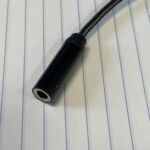Periodic Audio Rhodium
disclaimer: The Periodic Audio Rhodium was provided for review by Periodic Audio. I have no financial interest in Periodic, nor have I received any payment beyond the test unit itself for this review. If you have an interest in learning more about Periodic Audio products, See their website and Facebook. Right now Periodic has a promotion for Father’s day that includes a free Rhodium with purchase of a Carbon in-ear and Nickel Amp.
Packaging:
Packaging is very simple with a white card stock box with black lettering and the periodic table style layout we have come to expect from PA. Inside the box, we find the dongle itself and a USB type-C to type-A adapter. No USB to lightning adapter is provided and the Periodic website is quick to note that even with the camera kit, the Rhodium may not work with apple devices so this is best used for android, windows, Linux, and mac-OS where it is detected by plug and play and works well.
Build:
The dongle itself is tiny and one would be forgiven for assuming there was no dac in it as it seems there simply is not space to accommodate one. At the south end, we have a USB type C connector in a black polymer housing with a short strain relief then at the opposite end of the cloth wrapped cable we have a a round housing for the 3.5mm port. Again a short strain relief is provided. Overall length is just short of five inches with the USB connecting being just under 1 inch in length, three eighths of an inch wide, and roughly one quarter inch thick. The 3.5 port is also roughly one inch long with a quarter inch diameter. As suggested, this leaves little room for anything internally as space is certainly at a premium. The good news is the dongle weighs almost nothing and certainly wont be something you have to contend with when on the go.
Internals:
Periodic doesn’t list the chip used inside the Rhodium but a little digging using android and linux USB tools identifies the chip as either a Realtek ALC4042 or ALC4050. I have attached both datasheets for those interested in more details. Regardless of which of these two codecs is in use, the dongle supports up to 32bit / 384kHz PCM but does not support DSD or MQA which is a bit limiting by today’s standards. The specs list 31mW @32Ω which makes this best reserved for in-ears or extremely efficient headphones. I tried the Rhodium with several different models just to see how far I could push and definitely found some limits. Beyerdynamic’s 600Ω DT990 is definitely out as the Rhodium simply doesn’t have enough usable volume range for this. The HD6xx was better but still lacked enough volume range to really be useful. If I maxed out the volume, I could reach a comfortable listening level, but it had no headroom left for a crescendo at that point. With iems it fared a good bit better with the exception of the TinAudio P1 and the Tri I3 where it again struggled to have enough power to push them to full capability. Periodic markets the Rhodium as a pre-amp rather than a DAC/Amp which is probably a good way to think of it as alone it lacks the potency to drive all but the most sensitive of in ears. On the plus side, there was no his with my Magaosi K5 which is notoriously sensitive so it pairs well in those instances where more power is a drawback.
Sound:
It can be hard to determine exactly what any dac/amp brings to the mix as so much is dependent on source and headphones in use. The Rhodium does have good detail and clarity, but lacks some impact in the lows especially when paired with anything it struggles to drive. I found the Magaosi K5 paired well and had good detail retrieval, nice crisp mids, and acceptable bass (it never has a ton here anyway), but as I moved to harder to drive models, it quickly became evident that the Rhodium is meant as a pre-amp and not as a dac/amp by itself. When used with an amp following and thought of as a dac only, the Rhodium does a good job of staying neutral and rendering detail well.
Conclusions:
With makers coming out of the woodwork to provide USB to 3.5mm jack dongles for the cellphone market, it is no surprise that Periodic felt the need to have a model of their own to complement their in-ear offerings. The Rhodium offers a good level of detail and a quality build and does pair well with the Beryllium and Carbon models and the low output power does mean it helps conserve your phone battery which is a good thing if your in-ears don’t need additional power. The downside to that limited output is it either needs to be paired with an amp or doesn’t have the potency to drive over-ear models or high impedance / low sensitivity ear buds. This makes it a niche player at best as too many other dongles offer those features at nearly the same price. Periodic does market the the Rhodium as a pre-amp and even goes so far as to package the Rhodium with the Nickel amplifier and Carbon in ear as a kit and this is likely the best use case for the Rhodium as it functions well as a dac but needs a potent amplifier to complement it.
-
Packaging - 5/105/10
-
Accessories - 4/104/10
-
Build Quality - 6/106/10
-
Sound Quality - 6/106/10
-
Output Power - 3/103/10
Summary
Pros – tiny unit, simple operation, relatively low cost.
Cons – low power output, no Lightning option










